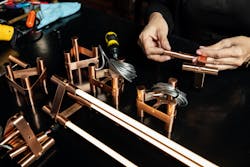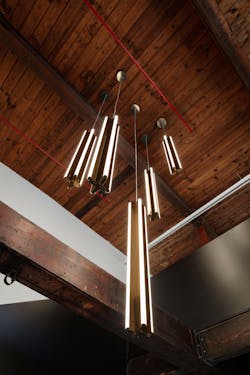LAST WORD | Domestic production shores up lighting innovation and speeds time-to-market
My choice to pursue lighting was twofold. My family ran a contract lighting business in Montreal, so entering the industry seemed natural. As a child, I had no choice but to learn about brass finishing, canopies, bobeches, and hickeys. In 2011, I left my banking career to start my own business with the vision that it would bring about change. What change? I wasn’t yet sure.
It was my experience working alongside management teams during my time in banking that allowed me to see the lighting industry from a different perspective. What I came to eventually realize is that the pioneering vision of purpose and change, while naïve, was accurate.
Like many traditional industries undergoing rapid change, the lighting industry was rife with innovation. I was intrigued by the potential of LED technology to reinvent the ubiquitous form factor of lighting fixtures, and it was exciting to imagine how technology could drive a wedge between architectural lighting products and other furniture, fixtures, and equipment. But intrigue alone was not enough. Every young company needs a big break.
For Juniper, that break was the THIN LED system launched in 2015, which is still one of the thinnest linear fixtures available. We used a reductive design philosophy to shrink the enclosure beyond what was considered possible while applying traditional brass materials and patinas to juxtapose the contemporary design with heirloom-quality finishes. While this was appealing to the market, the core innovation was the resulting system of simple parts that together formed endless kitted combinations. Each combination served a different purpose and solved a different problem. This concept formed our DNA and opened doors to a scalable model of domestic lighting manufacturing.
Many in the lighting industry believe that domestic manufacturing is unfeasible. High wages, less-skilled labor, dwindling industry clusters, and restrictive EPA regulations form the perceived downfall of the manufacturing model. Even a hybrid approach requires much of the same overhead investment. It is difficult to say exactly what percent of lighting sold by U.S. lighting companies is sourced overseas, but according to the National Electrical Manufacturers Association (NEMA), the U.S. lighting market was valued at $17.3 billion in 2020, and according to the U.S. Department of Commerce, $8.6 billion was imported.
At the core, domestic manufacturing is not about patriotism. Real U.S. incomes have risen on average 3% yearly since 1980 as manufacturing has fled our shores. So pragmatically, what benefits come from domestic manufacturing? Vertically integrating a business from design through engineering, manufacturing, and sales generates intangible, intrinsic value. This value is manifested through innovation, continuous improvement, and customer-centricity. Developing, prototyping, and manufacturing in-house helps employees develop an acute closeness to the product. We can solve problems more quickly and efficiently address changes in customer preferences, while lower inventory costs reduce waste and allow capital to flow into innovation.
Moreover, an ability to devise alternative manufacturing solutions can protect a business from external shocks. While the pandemic was wreaking havoc on the global supply chain in 2021, Juniper reduced its lead times through a process of manufacturing improvements. Granted, I had no foresight regarding the impending crisis, but it demonstrates how vertical integration can protect a business from unexpected global events.
Of course, ongoing production challenges take valuable time away from important business and sales activities, which could result in slower growth, while higher capital requirements tie up resources that could be used to expand acquisitively.
Ultimately, the choice to control manufacturing could affect your business culture in more ways beyond the cost structure. Nearly 50% of Juniper’s revenue involves some element of customization or permutable modifications of our lighting products. We offer this service at our standard lead times at little-to-no upcharge. Design changes often occur deep into a construction project’s timeline. It is therefore not surprising that our clients cite customization on short lead times as one of their primary needs, alongside budget. We have supported this need by staggering production into stages of completion. Raw materials are machined into partially processed parts that are later completed to custom specifications. We let some of those parts flow through our production system and fabricate them as standard unfinished parts to accommodate custom finishes and patinas. The remaining parts are processed into standard-issue finishes and prepped as subassemblies, which are kitted into specific client-specified arrangements. Each stage is designed to offer a different level of customization without imposing noticeably longer lead times. It is a form of mass customization that is made possible by a vertically integrated business model.
Innovation is a less obvious advantage of vertical integration. The now famous “designed in Cupertino, made in China” moniker proves that it is possible to successfully bisect innovation and production, but if your business is not large enough to exert power over your suppliers, you may find yourself compromising on product vision. When developing my first product, the M Lamp, I relied heavily on overseas vendors. They were gracious and accommodating, but the process was rigid, the changes were many, and their goodwill had limits. I stubbornly insisted on pursuing the underlying product intent — and that nearly took me out of business.
If architectural lighting products look suspiciously similar, they likely are made at or near the same place using existing and available technologies. Economies of scale are designed to get reliable products to market faster, cheaper, and with lower execution risk. The cost is homogeneity.
As we developed a new system of track lighting a few years ago, we understood that separating from the pack entailed a blank slate. We allowed pivots and scope creep in favor of creativity and fluidity. The goal was to solve problems not currently addressed by existing track systems. The Multiverse system will launch this spring, and to be sure, its success will be judged by the market, not by the process from which it spawned. However, without the ability to freely allocate production resources to prototyping efforts or to facilitate real-time communication between our production and engineering teams, I fear we would have been inclined to make compromises in favor of the status quo.
Whether vertical integration is a choice suited for the control obsessed, or whether it is one that promotes service and product innovation is rooted less in fact and more on one’s directive. Neither vertical integration nor offshoring guarantee financial success. The question is which business model is better suited for the problems you are trying to solve.
This column has been extended from the initial publication in the June 2023 issue of LEDs Magazine.
SHANT MADJARIAN is founder and creative director at Juniper Design Group, based in Brooklyn. With degrees in economics and finance from McGill University, Madjarian spent more than a decade in the banking industry before joining the entrepreneurial world with the launch of Juniper Design Group in 2011. Juniper combines form and function into luxury lighting designs for the architectural market, operating both a New York showroom and Connecticut manufacturing facility.
Follow our LinkedIn page for our latest news updates, contributed articles, and commentary, and our Facebook page for events announcements and more. You can also find us on Twitter.
Shant Madjarian | Founder, Juniper Design Group
SHANT MADJARIAN is founder and creative director at Juniper Design Group, based in Brooklyn. With degrees in economics and finance from McGill University, Madjarian spent more than a decade in the banking industry before joining the entrepreneurial world with the launch of Juniper Design Group in 2011. Juniper combines form and function into luxury lighting designs for the architectural market, operating both a New York showroom and Connecticut manufacturing facility.







![The DesignLights Consortium continues to make progress in shifting outdoor lighting products and implementation practices toward a more restrained and thoughtful strategy. [Image does not represent a DLC qualified fixture.] The DesignLights Consortium continues to make progress in shifting outdoor lighting products and implementation practices toward a more restrained and thoughtful strategy. [Image does not represent a DLC qualified fixture.]](https://img.ledsmagazine.com/files/base/ebm/leds/image/2024/08/66be810888ae93f656446f61-dreamstime_m_265700653.png?auto=format,compress&fit=&q=45&h=139&height=139&w=250&width=250)
